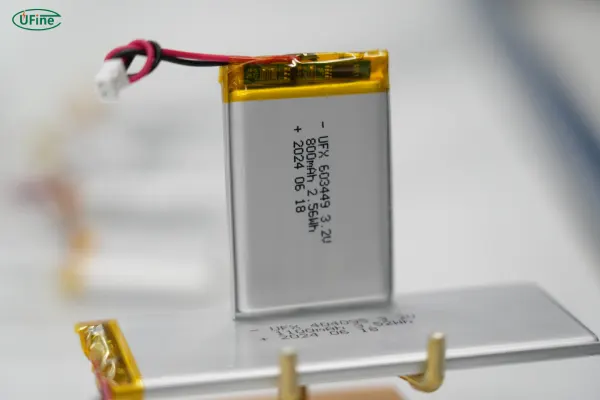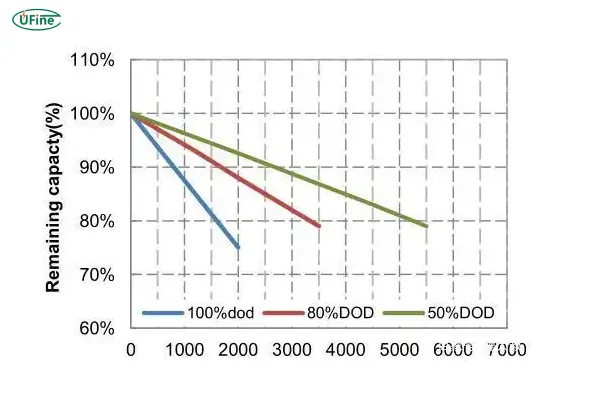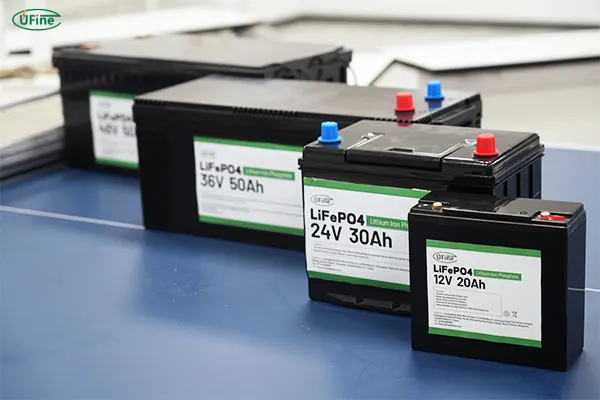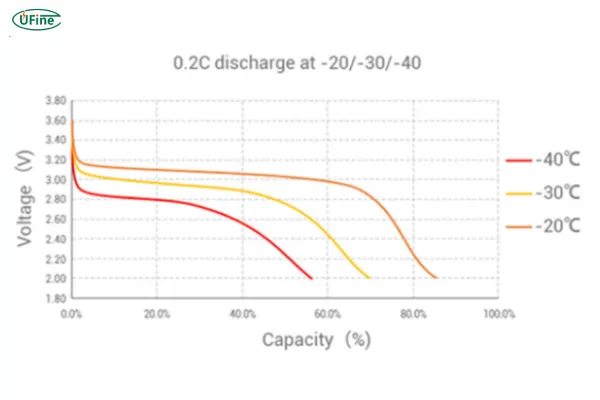Part 1. How is LiFePO4 battery life measured?
LiFePO4 battery life is typically measured using two main indicators:
- Charge Cycles: This is the most common standard for measuring battery life. A charge cycle refers to the process of discharging the battery from full to empty and then recharging it back to full. For LiFePO4 batteries, a typical charge cycle usually corresponds to using 80%-100% of the battery’s capacity in discharge and charge.
- Calendar Life: In addition to charge cycles, calendar life is another key metric for battery lifespan. This indicates how long a battery can function when not fully discharged or actively used, based on the aging effects of time and conditions.
Ufine Battery, a leading manufacturer with over 17 years of experience, specializes in customizing LiFePO4 batteries to ensure optimal lifespan based on your specific needs.
Part 2. How to calculate LiFePO4 battery life?
Calculating the LiFePO4 battery life involves considering several factors, such as charge cycles, depth of discharge (DoD), and usage conditions. Here’s a step-by-step breakdown of how to calculate the expected lifespan of a LiFePO4 battery:
1. Estimate the Number of Charge Cycles
The lifespan of a LiFePO4 battery is primarily measured in charge cycles. One charge cycle is defined as discharging the battery from 100% to 0% and then recharging it back to 100%. However, it’s important to note that batteries are rarely discharged fully in practice, so the typical cycle depth used is 80%-90% of the total capacity.
2. Typical LiFePO4 battery charge cycle:
A LiFePO4 battery generally lasts around 2000 to 5000 charge cycles, depending on usage conditions. Higher quality batteries, such as those offered by Ufine Battery, may exceed these numbers with proper management.
3. Consider Depth of Discharge (DoD)
The Depth of Discharge (DoD) plays a significant role in determining how long a battery will last. While most battery life estimates are based on a full discharge, LiFePO4 batteries typically last longer when discharged partially (e.g., between 20% and 80%).
- Shallow Discharge (e.g., 20% to 80%): Extends the battery’s life.
- Deep Discharge (e.g., 100%): Reduces the battery’s longevity.
If you frequently discharge a LiFePO4 battery by 50% (DoD), it could last up to 5000 charge cycles, but if you discharge it by 80% every time, the battery might last around 2000 cycles.
4. Calculate the Total Lifespan Based on Charge Cycles
Here’s a simple formula to calculate LiFePO4 battery life based on charge cycles:
Battery Life=Total Charge Cycles / Average Daily Discharge Rate
Total Charge Cycles: The estimated number of charge cycles (e.g., 3000 cycles).
Average Daily Discharge Rate: How often the battery is discharged each day (e.g., 1 full discharge per day = 1 cycle).
Example: If you have a LiFePO4 battery rated for 3000 charge cycles, and you typically use it for one cycle per day, the expected lifespan of the battery will be around 3000 days or approximately 8 years.
5. Temperature and Environmental Impact
The operating temperature and environmental conditions can have a substantial impact on the battery’s life. LiFePO4 batteries operate best in temperatures between 25°C and 35°C (77°F to 95°F). Extreme temperatures can reduce the total number of cycles and shorten battery life.
If the battery is frequently exposed to extreme heat or cold, this can lead to:
Reduced capacity over time.
Faster degradation of the internal components.
To extend the lifespan of your LiFePO4 battery, it’s critical to operate it within the recommended temperature range.
6. Real-Life Example: Calculating Lifespan
Let’s go through an example:
- Battery Model: 12V 100Ah LiFePO4 battery (rated for 3000 cycles).
- Average Discharge Depth: 50% (DoD).
- Daily Use: 1 full discharge per day (1 cycle).
Given this, we can calculate the lifespan as:
Battery Life=3000 cycles / (1 cycle/day )=3000 days≈8.2 years
However, if the DoD is reduced (e.g., only 30% of the battery is used per day), you can extend the lifespan by 2-3 times. In this case, the battery would last closer to 16 to 24 years.
7. Adjustments for Actual Usage
It’s important to adjust these calculations based on how the battery is used:
- Infrequent Use: If the battery is only used a few times per week, the lifespan could be much longer than expected.
- Heavy Use: If the battery is under heavy load or high discharge rates, the number of usable charge cycles will be reduced.
Part 3. How long is the LiFePO4 battery life?
The lifespan of a LiFePO4 battery typically ranges from 2000 to 5000 charge cycles. In practical terms, this translates to:
- Everyday Use: For home or commercial applications, the LiFePO4 battery can last between 10 to 15 years, which is significantly longer than traditional lead-acid batteries.
- Electric Vehicles (EVs): Many electric vehicles using LiFePO4 batteries can achieve a lifespan of 8 to 10 years, depending on usage and the battery management system (BMS) in place.
Part 4. What affects LiFePO4 battery life?
Several factors directly influence the LiFePO4 battery life:
- Charge Cycles: More cycles mean the battery will degrade over time, especially with deeper discharges.
- Temperature: High temperatures accelerate the chemical reactions in the battery, which can shorten its lifespan. Low temperatures may reduce charging efficiency.
- Battery Management System (BMS): An effective BMS helps control the voltage, current, and temperature during charging, thereby increasing the overall lifespan of the battery.
- Depth of Discharge (DoD): As mentioned, shallow discharges are more favorable for battery longevity than deep discharges.
Part 5. What is the average LiFePO4 battery life?
The average lifespan of a LiFePO4 battery is typically 10 to 15 years under normal operating conditions. This is a significant advantage over traditional lead-acid batteries, making LiFePO4 batteries the go-to choice for applications that require long-lasting, reliable energy storage.
Ufine Battery ensures that its LiFePO4 batteries are optimized for longevity and reliability, allowing customers to benefit from long service life in demanding environments.
Part 6. What is the maximum LiFePO4 battery life?
With proper usage, LiFePO4 batteries can achieve a maximum lifespan of 15+ years and withstand up to 5000 charge cycles. This is achieved under ideal conditions (e.g., proper temperature, shallow discharges, and efficient BMS), ensuring that the battery continues to perform well even after thousands of charge cycles.
Part 7. How to test LiFePO4 battery life?
Testing LiFePO4 battery life typically involves the following methods:
- Regular Capacity Testing: Periodically test the battery’s storage capacity to observe any degradation over time.
- Charge and Discharge Testing: Simulate real-world usage by performing charge and discharge cycles to assess the battery’s performance and longevity.
- Temperature Monitoring: Test how the battery performs under various temperature conditions to determine its durability and resistance to extreme heat or cold.
Ufine Battery offers professional battery testing services to help customers evaluate battery life and optimize performance for different applications.
Part 8. How to recognize when LiFePO4 battery life is ending?
Signs that a LiFePO4 battery is approaching the end of its life include:
- Significant Capacity Loss: The battery’s actual capacity has dropped by 20%-30% from its original capacity.
- Failure to Hold Charge: The battery loses its charge quickly, unable to maintain power for long durations.
- Overheating: The battery becomes excessively hot during charging or discharging, indicating potential damage or degradation.
- Decreased Charging Efficiency: Charging times are longer than usual, and the battery is not charging to its full capacity.
Part 9. How to extend LiFePO4 battery life?
To extend the LiFePO4 battery life, consider the following recommendations:
- Avoid Deep Discharge: Try to keep the battery between 20%-80% charge to maximize its lifespan.
- Maintain Optimal Temperature: Ensure the battery operates within the ideal temperature range of 25°C to 30°C to prevent overheating or freezing.
- Regular Maintenance: Periodically check the battery’s voltage, capacity, and health status. Perform cycle testing to monitor performance.
- Choose High-Quality Batteries: Select high-quality LiFePO4 batteries from reputable manufacturers like Ufine Battery, which customizes solutions to ensure longer lifespan and optimized performance.
Part 10. Conclusion
In conclusion, the LiFePO4 battery offers exceptional longevity, with an average lifespan of 10 to 15 years and up to 5000 charge cycles. Key factors such as charge cycles, depth of discharge, temperature, and battery management all play critical roles in determining battery life. By properly managing these factors, you can significantly extend the life of your LiFePO4 battery, making it a highly reliable energy storage solution for a wide range of applications.
For high-quality LiFePO4 battery solutions, Ufine Battery offers custom-designed batteries tailored to meet your specific needs. Whether for electric vehicles, solar energy storage, or industrial applications, we provide the best solutions for maximum performance and lifespan.
For more information or to get started on a custom battery solution, contact Ufine Battery today.
Related Tags:
More Articles

How to Choose the Best Floor Scrubber Battery for Commercial Cleaning?
Selecting the ideal floor scrubber battery ensures a long runtime, rapid charging, and minimal maintenance for efficient commercial cleaning operations.
Battery for Blower vs Battery for Leaf Vacuum: Which One Should You Choose?
Battery for blower vs leaf vacuum—learn the key differences in power, fit, and runtime to choose the right battery for your outdoor tool needs.
How to Choose the Right Battery for Blower?
Choosing the right blower battery? Consider voltage, capacity, chemistry & usage. This guide helps match the best battery for peak performance.
How to Choose the Best Insulated Battery Box for Lithium Batteries?
Choosing the Best Insulated Battery Box for Lithium Batteries? Discover key factors such as size, material, and safety for optimal protection and performance.
7 Critical Elements on a Lithium Battery Shipping Label
What must be on a lithium battery shipping label? Learn 7 key elements to ensure safety, legal compliance, and correct handling across all transport modes.







